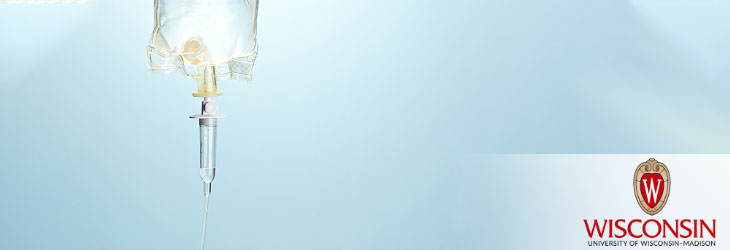Drug Delivery

Improved Micellar Delivery System for Hydrophobic or Fluorophilic Drugs
WARF: P06151US
Inventors: Sandro Mecozzi, Glen Kwon
The Wisconsin Alumni Research Foundation (WARF) is seeking commercial partners interested in developing highly stable and biocompatible micelles for the delivery of hydrophobic or fluorinated therapeutic agents.
Overview
Many drugs that are potentially efficacious for treating diseases such as cancer have limited usefulness because they are relatively insoluble and/or toxic. Polymeric micelles can serve as vehicles for the targeted delivery of such compounds. Micelles are unique among drug carrier systems due to their nanoscopic dimensions, hydrophilic shell and hydrophobic core. Encapsulating drugs in micelles results in better control of drug release, lower systemic toxicity and improved solubility. However, conventional micelles comprising only polyethylene glycol and phospholipid are not very stable in vivo and have a short half life in circulation.
The Invention
UW-Madison researchers have created highly stable and biocompatible micelles for the delivery of hydrophobic or fluorinated therapeutic agents. These micelles are self-assembled from semi-fluorinated copolymers consisting of discrete hydrophilic, fluorophilic and hydrophobic domains. Specifically, the copolymers may include blocks of polyethylene glycol, fluorocarbon and phospholipid.
Encapsulating hydrophobic and/or fluorophilic compounds with these micelles provides enhanced solubilization, protection and stabilization as compared to conventional drug delivery methods. The fluorophilic block effectively seals the hydrophobic core, making the micelles and therapeutic agents more stable, and can be modified to selectively “tune” the release rate of the encapsulated compound.
Encapsulating hydrophobic and/or fluorophilic compounds with these micelles provides enhanced solubilization, protection and stabilization as compared to conventional drug delivery methods. The fluorophilic block effectively seals the hydrophobic core, making the micelles and therapeutic agents more stable, and can be modified to selectively “tune” the release rate of the encapsulated compound.
Applications
- Intravenous delivery of relatively insoluble and/or toxic anticancer drugs, such as paclitaxel, rapamycin, geldanamycin or doxorubicin; toxic antifungal agents, such as Amphotericin B; and gaseous anesthetics and other fluorinated compounds
- Drug synthesis
- Analytic and diagnostic purposes
- Sequestering molecules for materials recovery
- Pollution abatement
- Formulation of flavoring agents and pigments
- Encapsulation of agricultural chemicals, such as fungicides and insecticides
- Nanotechnology
Key Benefits
- Highly stable and biocompatible under clinically relevant drug formulation, administration and delivery conditions
- Suitable for the intravenous delivery of relatively insoluble and/or toxic therapeutic agents
- Particularly well suited for combination drug therapies—can encapsulate mixtures of different hydrophobic and/or fluorophilic agents
- Capable of targeted delivery to specific cells, tissues or organs
- Superior overall stability, with inclusion of a fluorophilic component, as compared to micelles consisting of hydrophobic and hydrophilic blocks
- Composition of the fluorophilic block can be adjusted to enhance stability under different storage or delivery conditions and to provide faster or slower release rates.
- A fluorophilic group can be added to a hydrophobic drug prior to encapsulation to enhance the solubilization, stabilization and protection of the drug.
- Critical micelle concentration (the level at which the micelles start to break apart) is less than one micromole.
- Easy to store and deliver, and can circulate in the blood for a long time
Stage of Development
These micelles have been used successfully to encapsulate paclitaxel, a hydrophobic cancer drug.
Additional Information
For More Information About the Inventors
Tech Fields
For current licensing status, please contact Rafael Diaz at [javascript protected email address] or 608-960-9847